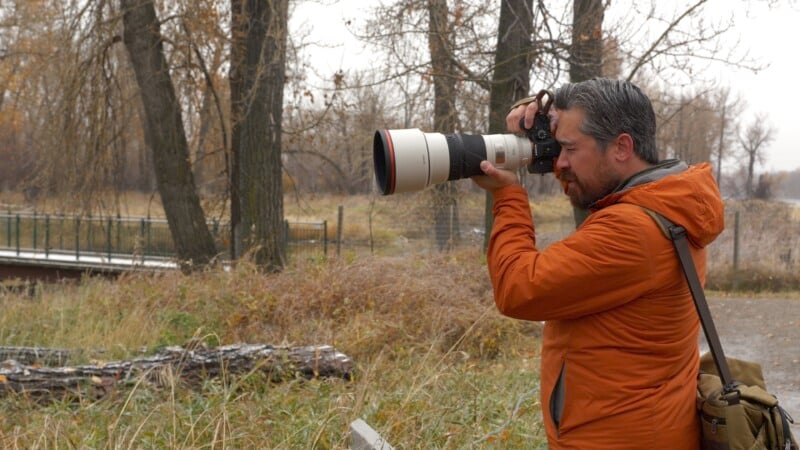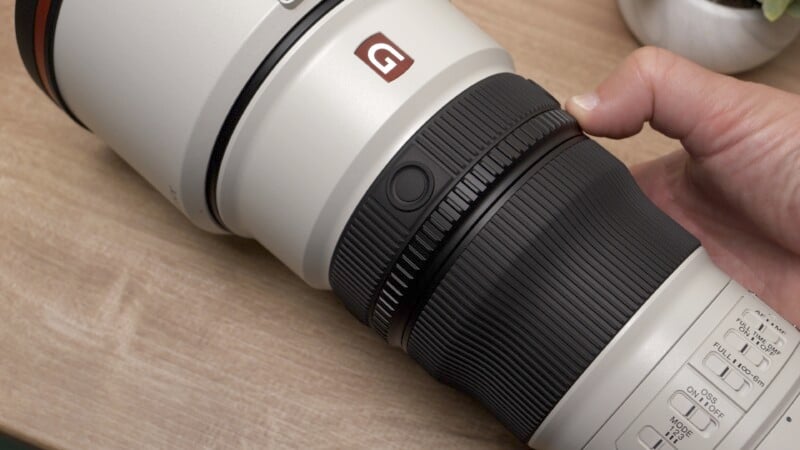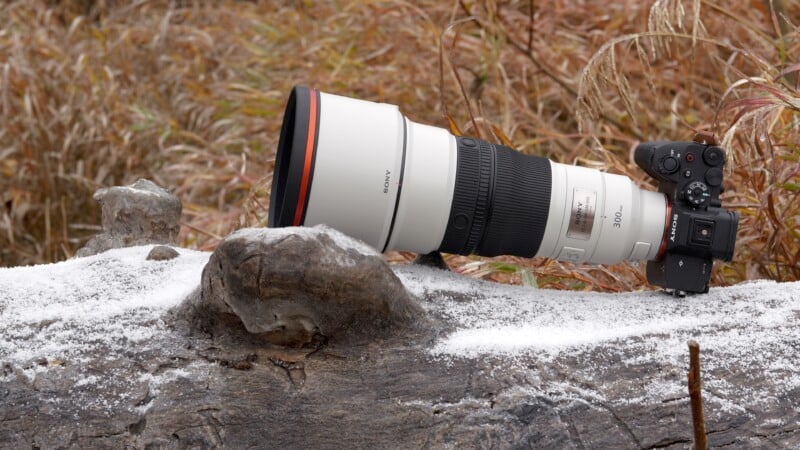
The world of mirrorless camera lenses is strangely devoid of professional 300mm lenses. That is, until now. Sony has released a brand new full-frame 300mm f/2.8 G Master lens and I had a chance to test it out.
To make matters difficult for us, in addition to a short review period to evaluate the lens, Calgary was hit by a freak snowstorm during that time. We went from 50 to 20 degrees overnight and the land was carpeted in snow. The show must go on, however, and some birds were bound to be out braving the weather, so we did too.
Sony 300mm f/2.8 GM OSS: How it Handles
When I first picked up the new 300mm I couldn’t believe it was actually an f/2.8 lens. Weighing in at only 52 ounces (1,470 grams) without the collar and being about the size of a compact 70-200mm zoom, I was stunned by how small Sony managed to make it. I had no issues handholding the lens.

The lens hood is easily removable with a button press and seems sturdy enough to protect the front element from bright light and the occasional bump. There are no filter threads for the front of the lens but instead, a removable 40.5mm drop-in filter is present near the camera mount. Being a G-Master lens, everything feels solid and sealed against any nasty conditions. The manual focus ring turns smoothly and there is a customizable control ring provided as well.

The weather caused all the local waterfowl to hunker down so I didn’t have any bird-in-flight opportunities but there were plenty of interesting ducks around. Even with the heavy snowfall, the 300mm had no problem focusing on birds using the Sony subject detection modes. Tracking was reliable as always and the speed with which the twin XD linear motors could drive the lens elements was impressive.

Sony 300mm f/2.8 GM OSS: Image Quality
Considering how compact the lens design is I wondered which — if any — compromises had to be made to the image quality of the lens. I can tell you that sharpness was certainly not one of them.
The 300mm delivers vibrant contrast and resolves to such a high degree at f/2.8 that I basically noticed no improvement when stopping the lens down. The lens is also extremely flat shooting, which is to say that the corners are in focus when the center is too. I rarely see a lens that delivers this resolving power regardless of the aperture chosen.

The generous lens hood combined with high-quality coatings makes the Sony 300mm resistant to lens flare and ghosting. I didn’t see any issues with chromatic aberrations — longitudinal or otherwise. If Sony did introduce optical compromises to make the lens this compact, I’m having a hard time finding them.

The lens renders specular highlights with a slight Cat’s eye effect at f/2.8 and when stopped down, maintains a fairly round shape. Importantly, what the lens does provide is a buttery smooth transition from out-of-focus to in-focus areas of the picture, and this is the kind of lens that excels at shallow depth-of-field shots. Wildlife and sports photographers will love the delicate separation of their subjects, starkly showcased against a smooth, soft background.

300mm f/2.8 GM OSS: A First That’s Unforgettable
It makes sense that Sony is the first to release a mirrorless 300mm f/2.8 lens because Canon and Nikon already have a stable of exceptional — albeit chunky — SLR lenses that can be adapted to their mirrorless bodies. It should be noted that Fujifilm also has a stunningly good 200mm f/2 lens, which is effectively the same kind of lens as what Sony is offering here given the equivalence between APS-C and full-frame sensors. However, it’s much larger and heavier despite being made for a smaller sensor.

Sony has certainly set the bar high and while I have no doubt that the other big players will soon release similar lenses, I wonder if they will be as compact and optically excellent. I certainly hope so.

Are There Alternatives?
Because this is a first for Sony there aren’t many other options. A G Master 70-200mm f/2.8 with a 1.4x teleconverter can be a versatile choice, albeit with a loss of light involved. Otherwise, the 400mm f/2.8 G Master is the next step up, both in size and price.
Should You Buy It?
Yes. If you are looking for a versatile telephoto lens that delivers some of the best image quality possible in a lens, look no further.



